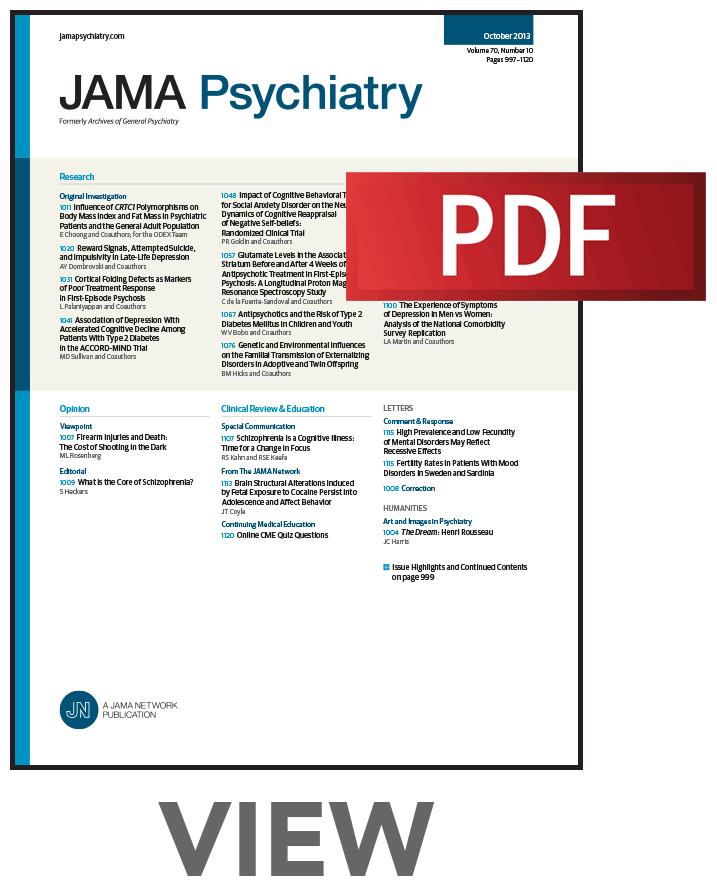Automating the Addiction Behaviors Checklist for Problematic Opioid Use Identification
IF 22.5
1区 医学
Q1 PSYCHIATRY
引用次数: 0
Abstract
ImportanceIndividuals whose chronic pain is managed with opioids are at high risk of developing an opioid use disorder. Electronic health records (EHR) allow large-scale studies to identify a continuum of problematic opioid use, including opioid use disorder. Traditionally, this is done through diagnostic codes, which are often unreliable and underused.ObjectiveTo determine whether regular expressions, an interpretable natural language processing technique, could automate a validated clinical tool (Addiction Behaviors Checklist) to identify problematic opioid use.Design, Setting, and ParticipantsThis cross-sectional study reports on a retrospective cohort with data analyzed from 2021 through 2023. The approach was evaluated against a blinded, manually reviewed holdout test set and validated against an independent test set at a separate institution. The study used data from Vanderbilt University Medical Center’s Synthetic Derivative, a deidentified version of the EHR for research purposes. This cohort comprised 8063 individuals with chronic pain, defined by diagnostic codes on at least 2 days. The study team collected free-text notes, demographics, and diagnostic codes and performed an external validation with 100 individuals with chronic pain from Geisinger, recruited from an interventional pain clinic cohort.Main Outcomes and MeasuresThe primary outcome was the evaluation of the automated method in identifying patients demonstrating problematic opioid use and its comparison with manual medical record review and opioid use disorder diagnostic codes. Methods with F1 scores were evaluated (a single value that combines sensitivity and positive predictive value at a single threshold) and areas under the curve (a single value that combines sensitivity and specificity across multiple thresholds).ResultsAmong the 8063 patients in the primary site (5081 female [63%] and 2982 male [37%]; mean [SD] age, 56 [16] years) and 100 patients in the validation site (57 female [57%] and 43 male [43%]; mean [SD] age, 54 [13] years), the automated approach outperformed diagnostic codes based on F1 scores (0.73; 95% CI, 0.62-0.83 vs 0.08; 95% CI, 0.00-0.19 at the primary site and 0.70; 95% CI, 0.50-0.85 vs 0.29; 95% CI, 0.07-0.50 at the validation site) and areas under the curve (0.82; 95% CI, 0.73-0.89 vs 0.52; 95% CI, 0.50-0.55 at the primary site and 0.86; 95% CI, 0.76-0.94 vs 0.59;95% CI, 0.50-0.67 at validation site).ConclusionsThis automated data extraction technique may facilitate earlier identification of people at risk for and who are experiencing problematic opioid use, and create new opportunities for studying long-term sequelae of opioid pain management.问题阿片类药物使用识别成瘾行为清单的自动化
使用阿片类药物治疗慢性疼痛的个体发生阿片类药物使用障碍的风险很高。电子健康记录(EHR)允许进行大规模研究,以确定有问题的阿片类药物使用的连续性,包括阿片类药物使用障碍。传统上,这是通过诊断代码完成的,这通常是不可靠的和未充分利用的。目的探讨正则表达式作为一种可解释的自然语言处理技术,是否可以自动化验证的临床工具(成瘾行为检查表)来识别阿片类药物的使用问题。设计、环境和参与者本横断面研究报告了一个回顾性队列,分析了2021年至2023年的数据。该方法通过盲法、人工审查的抵抗测试集进行了评估,并通过另一家机构的独立测试集进行了验证。这项研究使用了范德比尔特大学医学中心合成衍生物的数据,这是一种用于研究目的的去识别版电子病历。该队列包括8063名慢性疼痛患者,根据诊断代码定义至少2天。研究小组收集了自由文本笔记、人口统计数据和诊断代码,并对来自Geisinger的100名慢性疼痛患者进行了外部验证,这些患者来自介入性疼痛临床队列。主要结局和措施主要结局是评估自动方法识别有问题的阿片类药物使用患者,并与人工病历审查和阿片类药物使用障碍诊断代码进行比较。评估具有F1评分的方法(在单一阈值下结合敏感性和阳性预测值的单一值)和曲线下面积(在多个阈值下结合敏感性和特异性的单一值)。结果原发部位8063例患者中,女性5081例(63%),男性2982例(37%);平均[SD]年龄,56岁)和100例患者(女性57例[57%],男性43例[43%]);平均[SD]年龄,54 b[13]岁),自动方法优于基于F1评分的诊断代码(0.73;95% CI, 0.62-0.83 vs 0.08;95% CI,原发部位为0.00-0.19,0.70;95% CI, 0.50-0.85 vs 0.29;95% CI,验证点为0.07-0.50)和曲线下面积(0.82;95% CI, 0.73-0.89 vs 0.52;95% CI,主站点为0.50-0.55,0.86;95% CI, 0.76-0.94 vs 0.59;验证点95% CI, 0.50-0.67)。结论:这种自动化数据提取技术可以促进早期识别有阿片类药物使用风险和正在经历阿片类药物使用问题的人群,并为研究阿片类药物疼痛管理的长期后遗症创造新的机会。
本文章由计算机程序翻译,如有差异,请以英文原文为准。
求助全文
约1分钟内获得全文
求助全文
来源期刊

JAMA Psychiatry
PSYCHIATRY-
CiteScore
30.60
自引率
1.90%
发文量
233
期刊介绍:
JAMA Psychiatry is a global, peer-reviewed journal catering to clinicians, scholars, and research scientists in psychiatry, mental health, behavioral science, and related fields. The Archives of Neurology & Psychiatry originated in 1919, splitting into two journals in 1959: Archives of Neurology and Archives of General Psychiatry. In 2013, these evolved into JAMA Neurology and JAMA Psychiatry, respectively. JAMA Psychiatry is affiliated with the JAMA Network, a group of peer-reviewed medical and specialty publications.
 求助内容:
求助内容: 应助结果提醒方式:
应助结果提醒方式:


